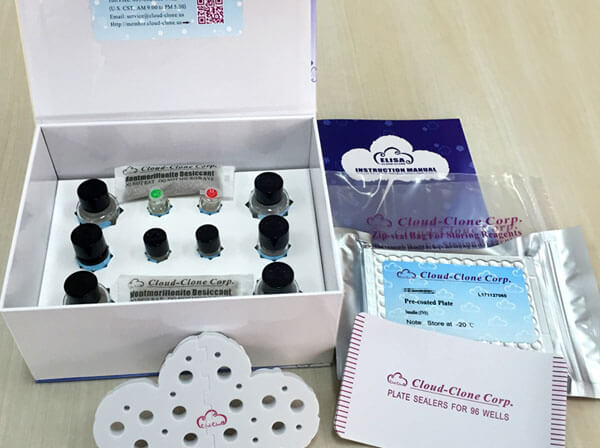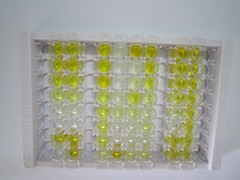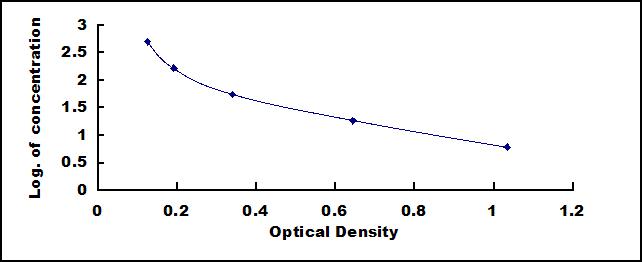ELISA Kit for Corticosterone (Cort) 

Corticosrone
- UOM
- FOB US$ 557.00 US$ 796.00 US$ 3,580.00 US$ 6,763.00 US$ 55,692.00
- Quantity
Overview
Properties
- Product No.CEA540Ge
- Organism SpeciesPan-species (General) Same name, Different species.
- ApplicationsEnzyme-linked immunosorbent assay for Antigen Detection.
Research use only - DownloadInstruction Manual
- CategoryInfection immunityEndocrinologyHormone metabolism
Sign into your account
Share a new citation as an author
Upload your experimental result
Review

Contact us
Please fill in the blank.
Recovery
Matrices listed below were spiked with certain level of Corticosterone (Cort) and the recovery rates were calculated by comparing the measured value to the expected amount of Corticosterone (Cort) in samples.
| Matrix | Recovery range (%) | Average(%) |
| serum(n=5) | 79-97 | 88 |
| EDTA plasma(n=5) | 79-89 | 82 |
| heparin plasma(n=5) | 98-105 | 101 |
Precision
Intra-assay Precision (Precision within an assay): 3 samples with low, middle and high level Corticosterone (Cort) were tested 20 times on one plate, respectively.
Inter-assay Precision (Precision between assays): 3 samples with low, middle and high level Corticosterone (Cort) were tested on 3 different plates, 8 replicates in each plate.
CV(%) = SD/meanX100
Intra-Assay: CV<10%
Inter-Assay: CV<12%
Linearity
The linearity of the kit was assayed by testing samples spiked with appropriate concentration of Corticosterone (Cort) and their serial dilutions. The results were demonstrated by the percentage of calculated concentration to the expected.
| Sample | 1:2 | 1:4 | 1:8 | 1:16 |
| serum(n=5) | 87-102% | 93-101% | 78-91% | 81-105% |
| EDTA plasma(n=5) | 99-105% | 78-92% | 80-89% | 79-95% |
| heparin plasma(n=5) | 84-92% | 89-98% | 88-98% | 80-101% |
Stability
The stability of kit is determined by the loss rate of activity. The loss rate of this kit is less than 5% within the expiration date under appropriate storage condition.
To minimize extra influence on the performance, operation procedures and lab conditions, especially room temperature, air humidity, incubator temperature should be strictly controlled. It is also strongly suggested that the whole assay is performed by the same operator from the beginning to the end.
Reagents and materials provided
| Reagents | Quantity | Reagents | Quantity |
| Pre-coated, ready to use 96-well strip plate | 1 | Plate sealer for 96 wells | 4 |
| Standard | 2 | Standard Diluent | 1×20mL |
| Detection Reagent A | 1×120µL | Assay Diluent A | 1×12mL |
| Detection Reagent B | 1×120µL | Assay Diluent B | 1×12mL |
| TMB Substrate | 1×9mL | Stop Solution | 1×6mL |
| Wash Buffer (30 × concentrate) | 1×20mL | Instruction manual | 1 |
Assay procedure summary
1. Prepare all reagents, samples and standards;
2. Add 50µL standard or sample to each well.
And then add 50µL prepared Detection Reagent A immediately.
Shake and mix. Incubate 1 hour at 37°C;
3. Aspirate and wash 3 times;
4. Add 100µL prepared Detection Reagent B. Incubate 30 minutes at 37°C;
5. Aspirate and wash 5 times;
6. Add 90µL Substrate Solution. Incubate 10-20 minutes at 37°C;
7. Add 50µL Stop Solution. Read at 450 nm immediately.

Test principle
This assay employs the competitive inhibition enzyme immunoassay technique. A monoclonal antibody specific to Corticosterone (Cort) has been pre-coated onto a microplate. A competitive inhibition reaction is launched between biotin labeled Corticosterone (Cort) and unlabeled Corticosterone (Cort) (Standards or samples) with the pre-coated antibody specific to Corticosterone (Cort). After incubation the unbound conjugate is washed off. Next, avidin conjugated to Horseradish Peroxidase (HRP) is added to each microplate well and incubated. The amount of bound HRP conjugate is reverse proportional to the concentration of Corticosterone (Cort) in the sample. After addition of the substrate solution, the intensity of color developed is reverse proportional to the concentration of Corticosterone (Cort) in the sample.
Giveaways
Increment services
Citations
- Intracerebroventricular injection of leukotriene B4 attenuates antigen-induced asthmatic response via BLT1 receptor stimulating HPA-axis in sensitized rats.PubMed: 20403205
- Effects of Gypenosides on Acute Stress in MicePapersearch: Source
- Role of adrenomedullin in the cerebrospinal fluid-contacting nucleus in the modulation of immobilization stressPubmed:25911494
- Sick Sinus Syndrome May Attribute to the Decrease of ?±-klotho Protein in MiceCom:Source
- Organ-Specific Activation of the Gastric Branch of the Efferent Vagus Nerve by Ghrelin in Urethane-Anesthetized RatsPubmed:24366191
- Regulation of corticosterone secretion is modified by PFOS exposure at different levels of the hypothalamic–pituitary–adrenal axis in adult male ratsPubmed:24440345
- Restraint stress alters immune parameters and induces oxidative stress in the mouse uterus during embryo implantationPubmed:25238024
- Diabetes alters the blood glucose response to ketamine in streptozotocin-diabetic ratsPubMed: 26379948
- Trivalent Chromium Attenuated Corticosterone Secretion and Actions in Adrenocorticotropic Hormone-Stimulated RatsIn_Press: 15-058.Pdf
- Ameliorating effects of gypenosides on chronic stress-induced anxiety disorders in micePubMed: 26370834
- Rats with differential self-grooming expression in the elevated plus-maze do not differ in anxiety-related behaviorsPubMed: 26142783
- Improvement of oral contraceptive-induced glucose dysreCavia (Guinea pig )lation and dyslipidemia by valproic acid is independent of circulating corticosteronePubmed:26855320
- Activation of cardiac renin–angiotensin system and plasminogen activator inhibitor-1 gene expressions in oral contraceptive-induced cardiometabolic disorderPubmed:26934364
- Electroacupuncture reCavia (Guinea pig )late hypothalamic–pituitary–adrenal axis and enhance hippocampal serotonin system in a rat model of depressionPubmed:26773866
- Moxibustion upreCavia (Guinea pig )lates hippocampal progranulin expression.Pubmed:27212922
- Lycopene ameliorates atrazine-induced oxidative damage in adrenal cortex of male rats by activation of the Nrf2/HO-1 pathwayPubmed:27102619
- Apelin-13 exerts antidepressant-like and recognition memory improving activities in stressed ratsPubmed:26853763
- Dopamine D2-like receptors modulate freezing response, but not the activation of HPA axis, during the expression of conditioned fear.pubmed:27766352
- Activation of ATP-sensitive potassium channel by iptakalim normalizes stress-induced HPA axis disorder and depressive behaviour by alleviating inflammation and oxidative stress in mouse hypothalamus.pubmed:28161195
- Effects of (-)-Sesamin on Chronic Stress-Induced Anxiety Disorders in Micepubmed:27995494
- Role of serotonin in the intestinal mucosal epithelium barrier in weaning mice undergoing stress-induced diarrheapubmed:29260435
- The Role of Psychological Stress on Heart Autophagy in Mice With Heart Failurepubmed:28691995
- Environmental perturbation of the circadian clock during pregnancy leads to transgenerational mood disorder-like behaviors in micepubmed:28974783
- Role of serotonin on the intestinal mucosal immune response to stress-induced diarrhea in weaning micepubmed:28633646
- Anxiety-like but not despair-like behaviors are further aggravated by chronic mild stress in the early stages of APPswe/PS1dE9 transgenic micedoi.org/10.1101/202283
- Rosiglitazone Exerts an Anti-depressive Effect in Unpredictable Chronic Mild-Stress-Induced Depressive Mice by Maintaining Essential Neuron Autophagy and Inhibiting Excessive Astrocytic Apoptosis.pubmed:28959186
- Effects of n-3 PUFA enriched and n-3 PUFA deficient diets in naïve and Aβ-treated female ratsPubmed:30028991
- Impact of Perfluorooctane Sulfonate on Reproductive Ability of Female Mice through Suppression of Estrogen Receptor a-Activated Kisspeptin Neurons10.1093:toxsci
- Multigenerational effects of dietary macronutrients intake on the metabolic phenotype of male Wistar rats10.1016:j.nut.2018.06.008
- Depressive-and anxiety-like phenotypes in young adult APPSwe/PS1dE9 transgenic mice with insensitivity to chronic mild stressPubmed:30012417
- Blockade of AT1 type receptors for angiotensin II prevents cardiac microvascular fibrosis induced by chronic stress in Sprague–Dawley ratsPubmed:29676198
- Differential Effects of Brain Death on Rat Microcirculation and Intestinal Inflammation: Female MalePubmed:29737476
- Curcumin attenuates chronic intermittent hypoxia-induced brain injuries by inhibiting AQP4 and p38 MAPK pathwayPubmed:29758366
- Chronic treatment with dexamethasone alters clock gene expression and melatonin synthesis in rat pineal gland at nightPubmed:30046256
- Tannins from fruits attenuates GABA antagonist‐induced anxiety‐like behaviour modulation of neurotransmittersPubmed: 30198561
- Expression of Hif-1α, Nf-κb, and Vegf Genes in the Liver and Blood Serum Levels of HIF-1α, Erythropoietin, VEGF, TGF-β, 8-Isoprostane, and Corticosterone in Wistar Rats with High and Low Resistance to Hypoxia. Corticosterone in …Pubmed: 30353332
- HMGB1-Mediated Differential Response on Hippocampal Neurotransmitter Disorder and Neuroinflammation in Adolescent Male and Female Mice following Cold ExposurePubmed: 30476565
- Establishment and evaluation of a novel mouse model of peri/postmenopausal depressionDoi: 10.1016/j.heliyon.2019.e01195
- Mice lacking Casp1, Ifngr and Nos2 genes exhibit altered depressive-and anxiety-like behaviour, and gut microbiome compositionPubmed: 31015500
- Antidepressant-like effects of dietary gardenia blue pigment derived from genipin and tyrosineDoi: 10.1039/C9FO00480G
- Synaptic structure and alterations in the hippocampus in neonatal rats exposed to lipopolysaccharidePubmed: 31288048
- Contribution of DNA methylation in chronic stress–induced cardiac remodeling and arrhythmias in micePubmed: 31431066
- MicroRNA-99a is a Potential Target for Regulating Hypothalamic Synaptic Plasticity in the Peri/Postmenopausal Depression ModelPubmed: 31540304
- Mice with nucleus tractus solitarius injury induced by chronic restraint stress present impaired ability to raise blood glucose and glucagon levels when blood glucose …Pubmed: 32249244
- GABA-mediated activated microglia induce neuroinflammation in the hippocampus of mice following cold exposure through the NLRP3 inflammasome and …Pubmed: 33166810
- Anxiolytic and Anti‑depressive Like Effects of Translocator Protein (18 kDa) Ligand YL‑IPA08 in a Rat Model of Postpartum DepressionPubmed: 32383026
- Pathophysiological Changes in Female Rats with Estrous Cycle Disorder Induced by Long-Term Heat StressPubmed: 32685488
- Neurobiological determinants of depressive-like symptoms in rodents
- Exposure to eagle owl feces induces anti-predator behavior, physiology, and hypothalamic gene responses in a subterranean rodent, the plateau zokor (Eospalax …
- Empagliflozin improves chronic hypercortisolism-induced abnormal myocardial structure and cardiac function in mice33294147
- Water-Soluble Carbon Dots in Cigarette Mainstream Smoke: Their Properties and the Behavioural, Neuroendocrinological, and Neurotransmitter Changes They ¡33762821
- O-GlcNAc/Akt pathway regulates glucose metabolism and reduces apoptosis in liver of piglets with acute cold stress33651993
- Sleep disturbance induces depressive behaviors and neuroinflammation by altering the circadian oscillations of clock genes in rats33785408
- A Famous Chinese Medicine Formula: Yinhuo Decoction Antagonizes the Damage of Corticosterone to PC12 Cells and Improves Depression by Regulating …Pubmed:35281603
- Monochromatic blue light not green light exposure is associated with continuous light-induced hepatic steatosis in high fat diet fed-mice via oxidative stressPubmed:35588616











